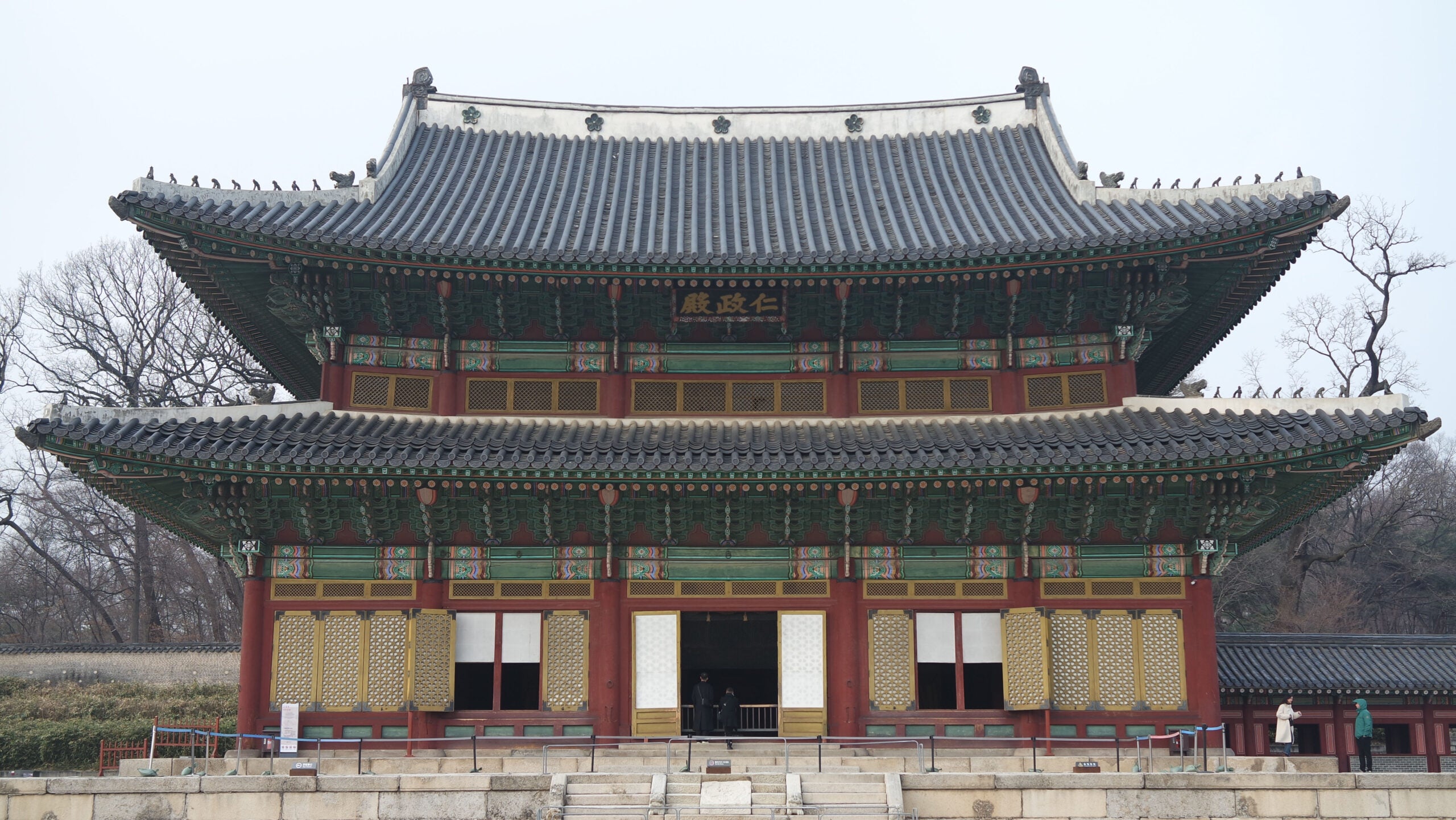Impactful Immersion: Georgetown’s Magis Trip to Korea
Korean Catholics and the Interfaith Quest for Justice
By Jennon Bell Hoffman
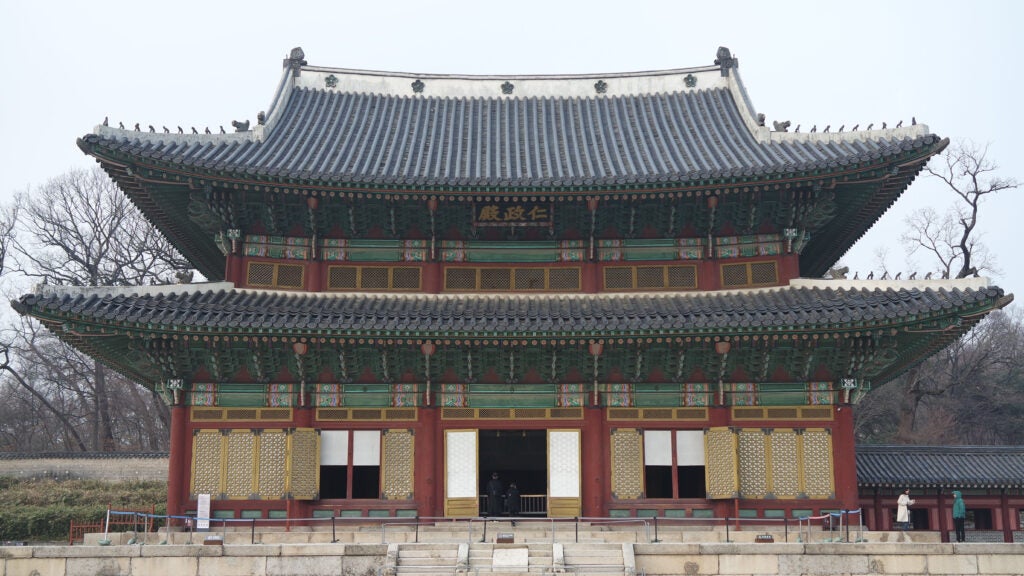
The main throne room of Changdeokgung Palace, Jongno District, Seoul, South Korea. Photo by Liz Elliott (C’26)
When Liz Elliott was twelve years old, she began teaching herself how to read Korean in order to better understand the lyrics of her favorite K-pop songs. Less than a decade later, the linguistics sophomore can hardly believe she just spent 10 days immersed in the Korean culture as part of her spring break with the Georgetown Magis Immersion program.
“Every time one of my friends has asked me, ‘How was your spring break?’ Immediately I’m like, ‘It was amazing! It was fantastic!’ I’m so excited to tell people about it, to share it with everyone, but I’m still in awe. I have no words.”
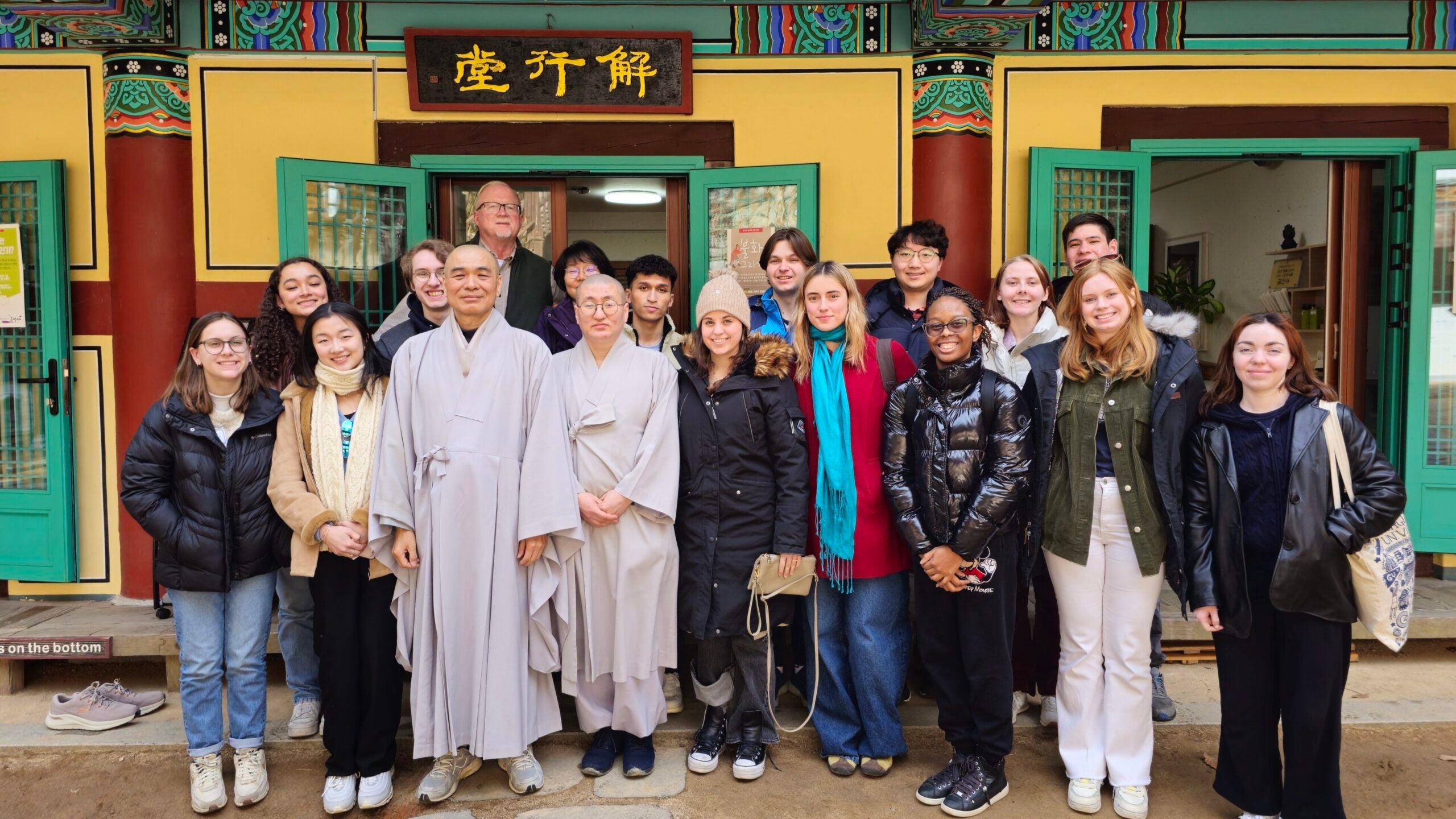
Georgetown students with trip leaders Fr. Ryan Maher, S.J., and Professor Min-ah Cho with two monks at Geumsunsa Temple in Seoul (a 600-year-old Buddhist Temple). Photo by Liz Elliott (C’26)
Liz, along with 13 students this year, recently returned from their respective Magis Immersion Seminars (MIS) that took them to sites in Korea, Jordan, Greece, and Rome to get an on-the-ground experiential week of learning during Spring Break. The itineraries are jam-packed with lectures, sightseeing, interviews with locals, meetings with spiritual leaders, home visits, and communal gatherings to help build relationships, cultivate awareness of social justice, and engage in reflection and solidarity with the poor.
Though Liz says she had a fairly decent amount of background knowledge about Korea and Korean culture, thanks to a summer abroad trip when she was 15, she was ultimately drawn to the Magis trip because of the Christian connection.
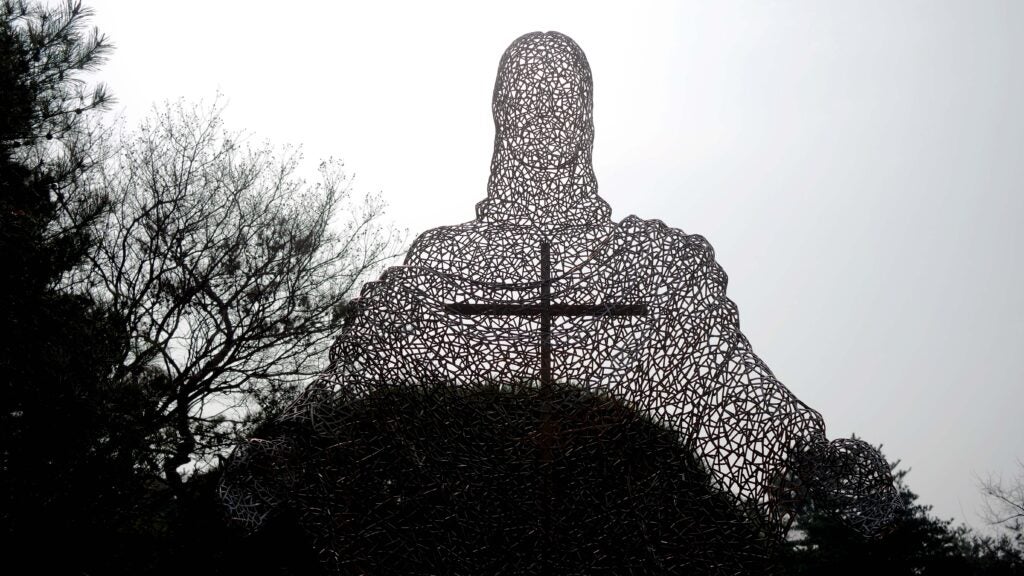
A statue of Jesus at the Jeoldusan Martyrs’ Shrine in Seoul. (Photo by Liz Elliott)
“When I was 15, I remember riding the subway at night by myself and I would look out and I would just see the skyline and I kept seeing these fluorescent red crosses everywhere. But I had no connection to Christianity in Korea at the time because my host family was non-religious. But the image has always stuck in my head. I wanted to learn more about this aspect of Korean society, especially Korean theology.”
The course, titled “Korean Catholics and the Interfaith Quest for Justice,” and taught by Dr. Min-Ah Cho examines how justice and peace lie within and beyond the context of Catholicism in Korea. To learn more about Christianity in Korea, Liz and her classmates spent ten days journeying from Seoul, to Paju, a city near the border of North Korea, to the tropical island of Jeju. At each stop, the group met with local individuals, including Korean Jesuits, scholars, activists, and students, to learn, discuss, and engage with the culture and events that shaped Korea throughout time. Many of the sites were culturally important, but one stood out to Liz as both historically impactful and personally moving.
“We visited War and Women’s Human Rights Museum in Seoul, which was a museum about “comfort women”, women and girls who were forced into large-scale sexual slavery when Japan colonized Korea during WWII. We learned how it was covered up by the Japanese government and no one in the public really knew about it until 50-some years later. Even when we talked about it in class, I felt really moved by what we were learning. But being there and seeing the stories of these women, and what terrible things happened to them, really affected me. I cried through the entire museum.”
Liz says that she felt it was so important and impactful to bear witness to the museum and the stories it shared because there are lessons to be applied today about recognition, acknowledgment, and restoring dignity. She draws hope from another experience she had on the trip: learning about the Wednesday Demonstrations.
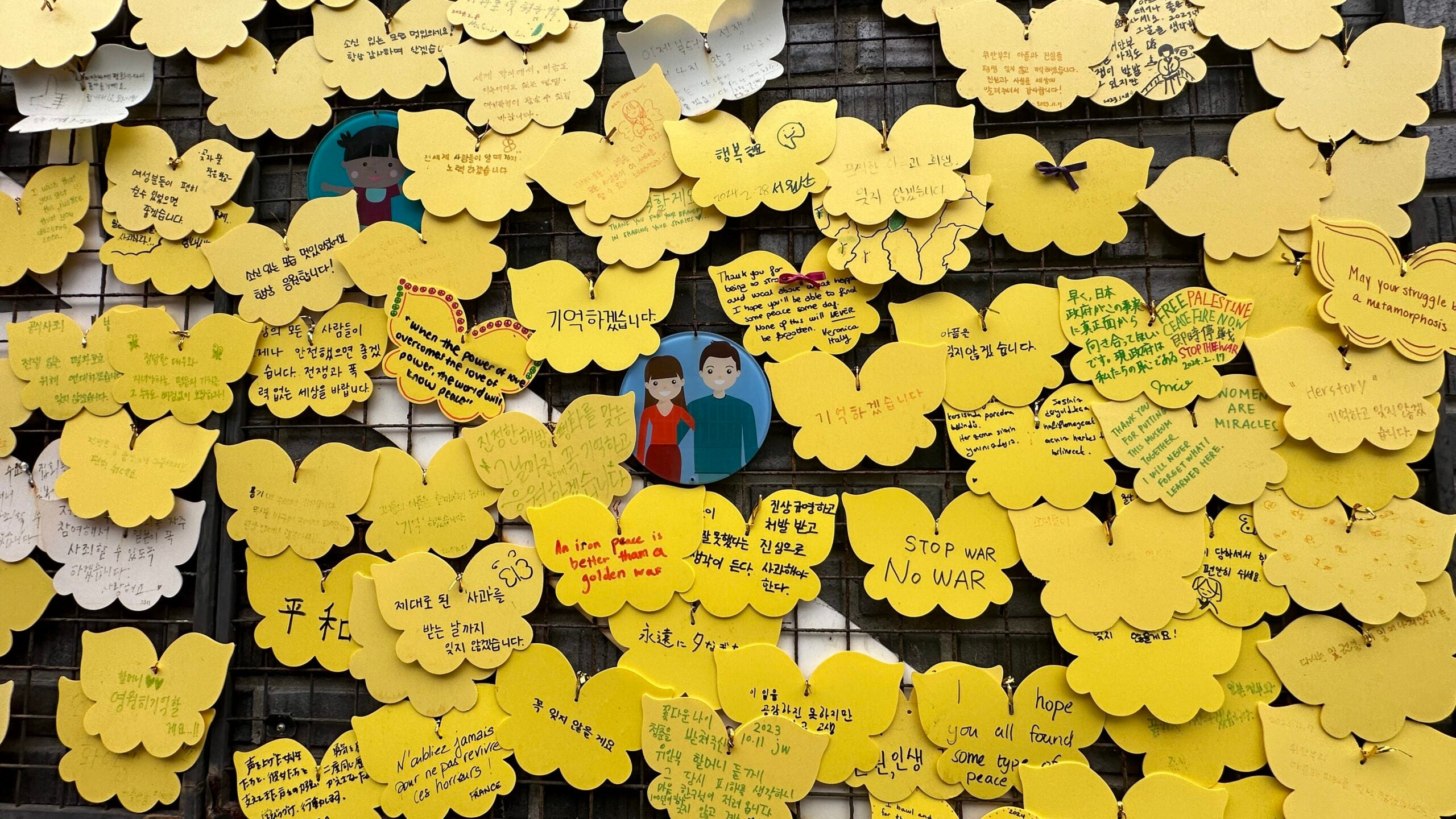
Visitors to the War and Women’s Human Rights Museum write their thoughts about the museum and hopes for the future on these yellow butterflies and post them on a wall in the museum. (Photo by Liz Elliott)
“After absorbing so much sadness and tragedy, it was inspiring to learn about the Wednesday protests, where a group of activists gather every Wednesday to give their seven demands and ask for an official apology from the Japanese government, an acknowledgment of the experiences to help restore the dignity of the women. They’ve been meeting regularly for over 30 years; in 2002, it held the Guinness record for the world’s oldest protest rally on a single theme.”
Liz says that seeing such hope and optimism in light of the tragedy, for the continued fight for justice and recognition, connected with her so deeply, and through these experiences, created open conversation and bonding opportunities with her classmates.
“Over the course of the trip, just spending that much time together, we would connect and share. For example, after this museum, we had a talk afterwards with two volunteers who gave us more information and insight. Everywhere we went, the people were so inviting and welcoming. I think their openness to share really spoke to the culture and my experience of the people while in Korea. I am so appreciative for my time there.”
Now that she is back on campus, Liz is still processing her trip and all the feelings and emotions that it brought up. Most importantly, Liz says she feels that this once-in-a-lifetime experience gave her more than an education.
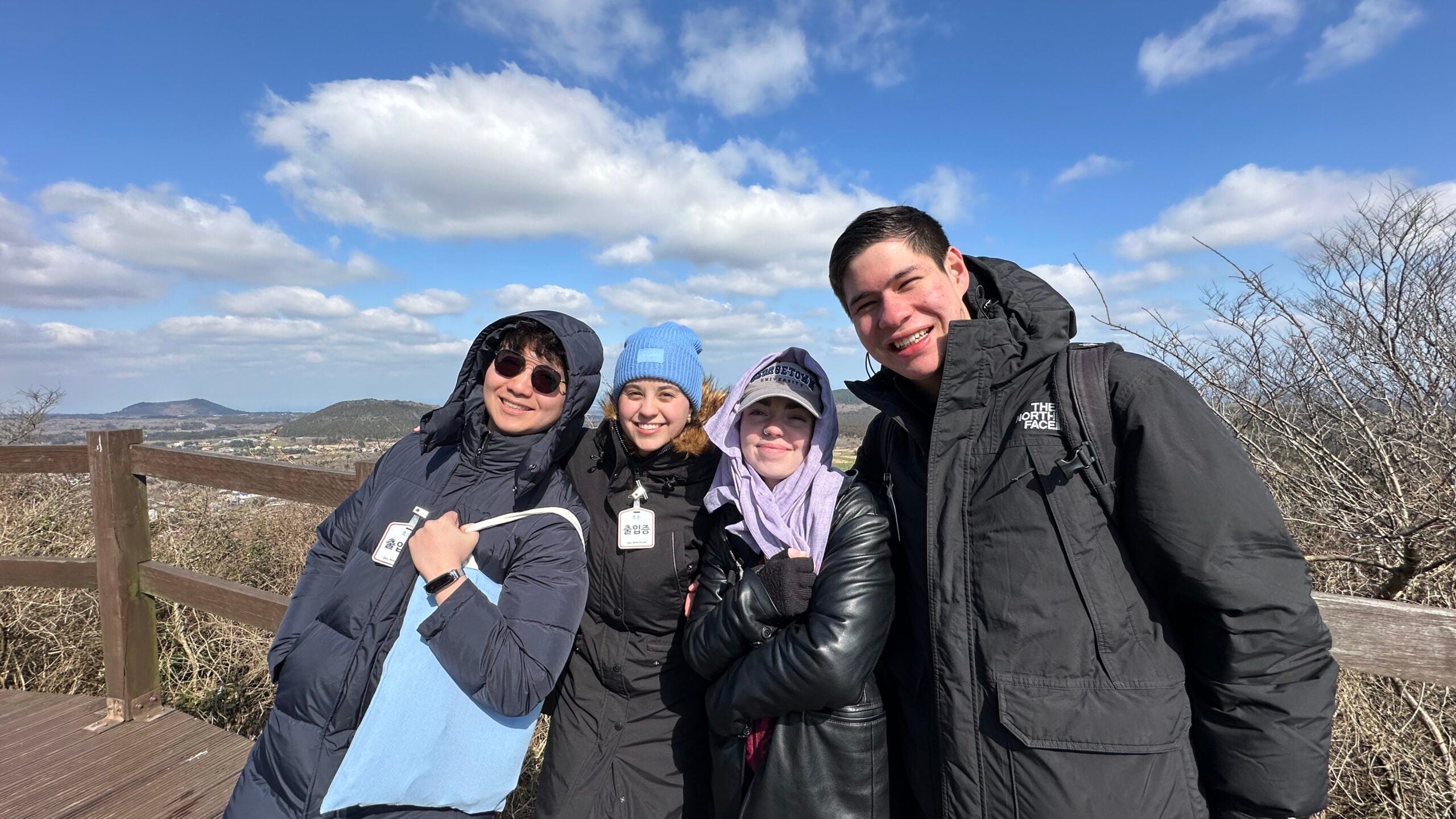
On a hike in Jeju Island. From left to right, Peter Kim, Maria Victoria Almeida Vazquez, Liz Elliott, and Maximilian Goetz. (Photo courtesy of Liz Elliott)
“I knew when I signed up this wasn’t going to be a vacation, not at all. I knew we’d be learning and I was excited about that. But now that I’m back, I think that this was so much more valuable, more than a vacation could ever be. Every day, you’re going to learn more about a different culture that you really couldn’t experience in the classroom. It’s eye-opening and life-changing, for sure.”
Magis, the Ignatian ideal of more, asks people to go deeper and pay more intimate attention to their feelings, experiences, and significant relationships with God and others.
The Magis Immersion Seminars put this ideal into practice by focusing on relationships, and cultivating awareness of social justice, and engaging in reflection and solidarity with the poor.
After this trip, Liz says the Georgetown mission hits a lot harder. “You can really connect with the stories and understand the people and history better. I feel like it was just so good for me to be part of and I’m so thankful and deeply grateful that I was.”
Liz Elliott (C’26) is studying Linguistics.
Dr. Min-Ah Cho is an Assistant Teaching Professor, at the Department of Theology and Religious Studies.
Fr. Ryan Maher, S.J., is the administrator of the Georgetown Jesuit Community.
Jennon Bell Hoffmann is a freelance writer and editor living in Chicago.
- Tagged
- Korea
- Magis
- Spring Break
